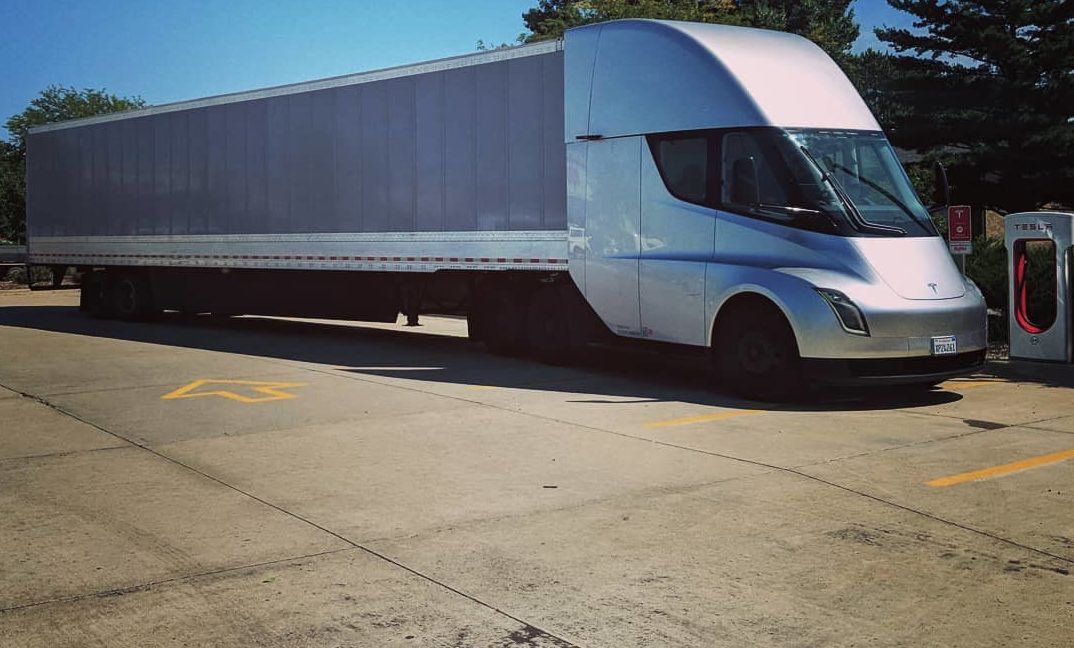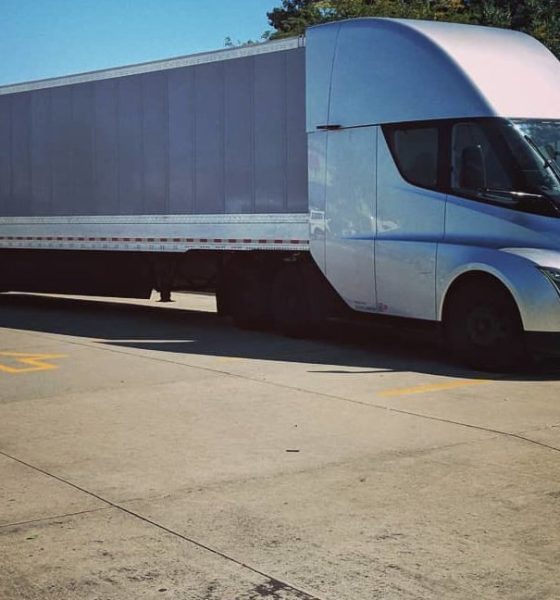

News
Tesla Semi returns to Des Moines, IA as road tests and customer visits continue
Just a few days after visiting UPS’ hub in Addison, IL, the Tesla Semi has been spotted in Des Moines, IA. The Semi’s interstate travels appear to be part of the company’s continued road tests, which also involve visits to some of its reservation holders.
This is actually not the first time the Tesla Semi was photographed in Des Moines. Last April, the matte black Tesla Semi, an operational prototype that has not been spotted on roads lately, was sighted being transported heading east into I-80 in the Des Moines, IA area. Des Moines hosts the headquarters of Ruan Transportation Management Systems, one of Tesla’s reservation holders for the Semi.

Ruan noted in an announcement back in January that it had been in touch with Tesla about the upcoming all-electric long-hauler even before the Semi was unveiled in November. Over the months leading up to the vehicle’s reveal, Ruan was invited by Tesla to take part in on-site meetings and discussions about the vehicle.
Ruan announced an order of 5 Tesla Semis in January, though it has not provided an update since then. Considering that the Tesla Semi has been making the rounds visiting some reservation holders like J.B. Hunt and UPS, it would not be too surprising if Ruan’s headquarters would soon get a visit from the prototype electric truck as well.
Tesla’s recent visits and sightings are quite notable, in the way that the company appears to be adopting a more open stance about the vehicle. Anecdotes from members of the Tesla community fortunate enough to come across the Semi indicate that the team accompanying the truck are incredibly willing to answer any questions about the long-hauler. Apart from this, the truck’s recent visits to reservation holders like J.B. Hunt and UPS were also a lot more hands-on and interactive. The truck’s recent visit at the Addison, IL UPS hub, for one, even involved rides (and seemingly even test drives) in the vehicle.
Tesla had around 2,000 reservations for the Semi as of the Q1 2018 earnings call last May. The company has not issued an update on the number of pre-orders for the truck since then, though Elon Musk noted during the Q2 2018 earnings call that Tesla is still in the process of improving the vehicle’s capabilities before it enters production.
The Tesla Semi could be the company’s most disruptive vehicle in its lineup, considering that the trucking industry is responsible for the transportation of up to 71% of food, retail goods, construction supplies, and other cargo delivered to customers and businesses every day. The industry is steadily growing as well, with the trucking market generating $700.3 billion in economic activity last year, a 3.5% increase compared to the $676.6 billion it made in 2016.
Just like Tesla’s other vehicles, the Semi boasts impressive specs. The electric truck is powered by four Model 3-derived electric motors, which give it instant torque. The Semi is also rated as a Class 8 truck, and is listed with a 0-60 mph time of 5 seconds flat when accelerating without cargo. The Semi is expected to be released in two variations — a 300-mile short-range variant and a 500-mile long-range version. That said, Elon Musk has noted that the long-range Semi could have closer to 600 miles of range per charge.

News
Tesla starts showing how FSD will change lives in Europe
Local officials tested the system on narrow country roads and were impressed by FSD’s smooth, human-like driving, with some calling the service a game-changer for everyday life in areas that are far from urban centers.

Tesla has launched Europe’s first public shuttle service using Full Self-Driving (Supervised) in the rural Eifelkreis Bitburg-Prüm region of Germany, demonstrating how the technology can restore independence and mobility for people who struggle with limited transport options.
Local officials tested the system on narrow country roads and were impressed by FSD’s smooth, human-like driving, with some calling the service a game-changer for everyday life in areas that are far from urban centers.
Officials see real impact on rural residents
Arzfeld Mayor Johannes Kuhl and District Administrator Andreas Kruppert personally tested the Tesla shuttle service. This allowed them to see just how well FSD navigated winding lanes and rural roads confidently. Kruppert said, “Autonomous driving sounds like science fiction to many, but we simply see here that it works totally well in rural regions too.” Kuhl, for his part, also noted that FSD “feels like a very experienced driver.”
The pilot complements the area’s “Citizen Bus” program, which provides on-demand rides for elderly residents who can no longer drive themselves. Tesla Europe shared a video of a demonstration of the service, highlighting how FSD gives people their freedom back, even in places where public transport is not as prevalent.
What the Ministry for Economic Affairs and Transport says
Rhineland-Palatinate’s Minister Daniela Schmitt supported the project, praising the collaboration that made this “first of its kind in Europe” possible. As per the ministry, the rural rollout for the service shows FSD’s potential beyond major cities, and it delivers tangible benefits like grocery runs, doctor visits, and social connections for isolated residents.
“Reliable and flexible mobility is especially vital in rural areas. With the launch of a shuttle service using self-driving vehicles (FSD supervised) by Tesla in the Eifelkreis Bitburg-Prüm, an innovative pilot project is now getting underway that complements local community bus services. It is the first project of its kind in Europe.
“The result is a real gain for rural mobility: greater accessibility, more flexibility and tangible benefits for everyday life. A strong signal for innovation, cooperation and future-oriented mobility beyond urban centers,” the ministry wrote in a LinkedIn post.
News
Tesla China quietly posts Robotaxi-related job listing
Tesla China is currently seeking a Low Voltage Electrical Engineer to work on circuit board design for the company’s autonomous vehicles.

Tesla has posted a new job listing in Shanghai explicitly tied to its Robotaxi program, fueling speculation that the company is preparing to launch its dedicated autonomous ride-hailing service in China.
As noted in the listing, Tesla China is currently seeking a Low Voltage Electrical Engineer to work on circuit board design for the company’s autonomous vehicles.
Robotaxi-specific role
The listing, which was shared on social media platform X by industry watcher @tslaming, suggested that Tesla China is looking to fill the role urgently. The job listing itself specifically mentions that the person hired for the role will be working on the Low Voltage Hardware team, which would design the circuit boards that would serve as the nervous system of the Robotaxi.
Key tasks for the role, as indicated in the job listing, include collaboration with PCB layout, firmware, mechanical, program management, and validation teams, among other responsibilities. The role is based in Shanghai.
China Robotaxi launch
China represents a massive potential market for robotaxis, with its dense urban centers and supportive policies in select cities. Tesla has limited permission to roll out FSD in the country, though despite this, its vehicles have been hailed as among the best in the market when it comes to autonomous features. So far, at least, it appears that China supports Tesla’s FSD and Robotaxi rollout.
This was hinted at in November, when Tesla brought the Cybercab to the 8th China International Import Expo (CIIE) in Shanghai, marking the first time that the autonomous two-seater was brought to the Asia-Pacific region. The vehicle, despite not having a release date in China, received a significant amount of interest among the event’s attendees.
Elon Musk
Elon Musk and Tesla AI Director share insights after empty driver seat Robotaxi rides
The executives’ unoccupied tests hint at the rapid progress of Tesla’s unsupervised Robotaxi efforts.

Tesla CEO Elon Musk and AI Director Ashok Elluswamy celebrated Christmas Eve by sharing personal experiences with Robotaxi vehicles that had no safety monitor or occupant in the driver’s seat. Musk described the system’s “perfect driving” around Austin, while Elluswamy posted video from the back seat, calling it “an amazing experience.”
The executives’ unoccupied tests hint at the rapid progress of Tesla’s unsupervised Robotaxi efforts.
Elon and Ashok’s firsthand Robotaxi insights
Prior to Musk and the Tesla AI Director’s posts, sightings of unmanned Teslas navigating public roads were widely shared on social media. One such vehicle was spotted in Austin, Texas, which Elon Musk acknowleged by stating that “Testing is underway with no occupants in the car.”
Based on his Christmas Eve post, Musk seemed to have tested an unmanned Tesla himself. “A Tesla with no safety monitor in the car and me sitting in the passenger seat took me all around Austin on Sunday with perfect driving,” Musk wrote in his post.
Elluswamy responded with a 2-minute video showing himself in the rear of an unmanned Tesla. The video featured the vehicle’s empty front seats, as well as its smooth handling through real-world traffic. He captioned his video with the words, “It’s an amazing experience!”
Towards Unsupervised operations
During an xAI Hackathon earlier this month, Elon Musk mentioned that Tesla owed be removing Safety Monitors from its Robotaxis in Austin in just three weeks. “Unsupervised is pretty much solved at this point. So there will be Tesla Robotaxis operating in Austin with no one in them. Not even anyone in the passenger seat in about three weeks,” he said. Musk echoed similar estimates at the 2025 Annual Shareholder Meeting and the Q3 2025 earnings call.
Considering the insights that were posted Musk and Elluswamy, it does appear that Tesla is working hard towards operating its Robotaxis with no safety monitors. This is quite impressive considering that the service was launched just earlier this year.








